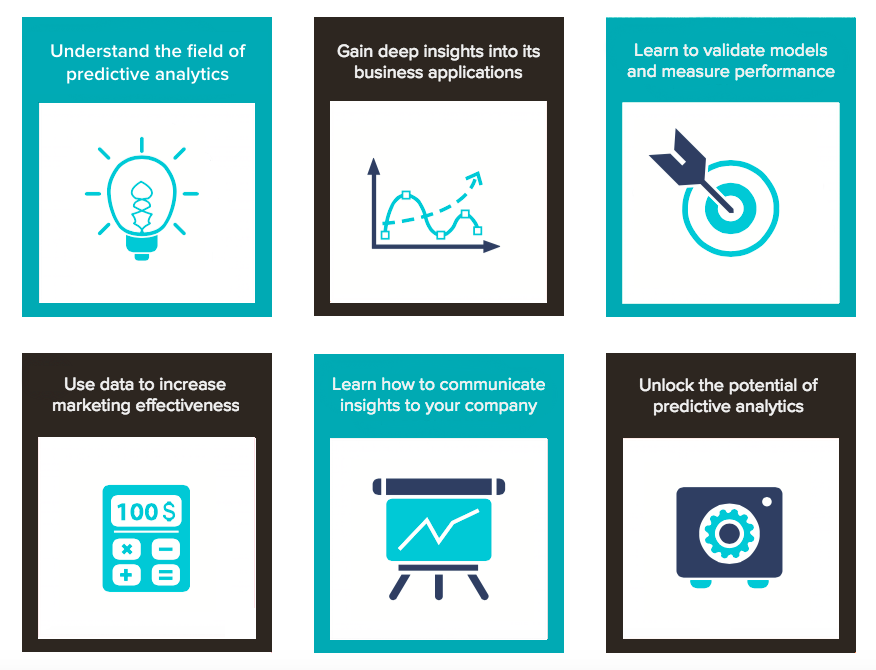What is the course about?
Today’s customers are overwhelmed with information and choices, and often struggle to find the product or service that best fit their needs. Advances in technology, data and analytics make it possible to help these customers by offering the right product, while providing the service they expect. Companies are increasingly looking for ways to use data in order to deliver the right kind of products, offers and services to the most valuable customers.
This course will provide you with insights into predictive modelling and its applications in commerce. Applying predictive analytics can help your company grow and increase their marketing performance. By the end of this course, you will feel confident to apply predictive analytics resulting in an increase in customer satisfaction, company performance and even team performance.
What will I learn during this course?
This course will teach you how to identify situations in which predictive analytics can add value by better meeting customer needs, smarter allocation of marketing budgets and improving the financial performance of the company.
You will know when to use the following modelling techniques and understand their pros and cons:
• Logistic regression
• Decision tree
• Random forest
In the end, you will be able to apply all learned theory into practice and start building a more data-driven culture within your organisation.

Chapter 1: The Power of Predictive Analytics in Commerce
‘Data Scientist’ was recently called the sexiest job of the 21st century, and we believe that is true. The availability of data is exponentially growing and data analytics is at the heart of many successful companies. We will provide you with examples and inspiration on predictive analytics and convince you of its power in commerce.
Chapter 2: Cross-Selling to the Right Customer
Cross-selling is the strategy of matching needs of current customers with product offerings. Since targeting all your current customers with your product is neither efficient nor desirable, this chapter will show you how logistic regression as a modelling technique can be used to select customers with the highest cross-sell potential.
Chapter 3: Providing the Next Best Offer
Making a personalised product proposal based on customer characteristics, purchase context and/or product characteristics is referred to as next best offer. We explain how decision trees can help you in providing the best suitable offer to your customers, which gives them the feeling that you understand their needs and increases conversion.
Chapter 4: Preventing Customers to Leave
Many triggers in a customer lifetime might cause customers to leave your company (think about a complaint, an increase in price or a change in their product). By using random forest, all relevant triggers can be identified, such that customers who are most likely to churn can be addressed and retention measures can be made.
Chapter 5: A Data-Driven Company as a Foundation for Success
Now that you have learned so many new predictive modelling techniques, how are you going to communicate and apply them in your daily work? This chapter will help you identify the maturity of your organisation as a data-driven company and will give you tools how to grow towards a more data-driven organisation. In the end, all organisations need to embrace data analytics in order to survive in this data-oriented world.
Who should take this course?
This course is suited for a variety of different experience levels. We invite anyone who is eager to learn more about data analytics and predictive modelling to join us. More specific groups include:
• Marketers who want to learn more about predictive modelling and especially what data can do for you.
• Data scientists who want to bring their modelling as well as data presentation skills one step further.
• Business managers who want to have a better grasp and understanding of data models and how to build a strategy based on this data.
What should I know before the course begins?
This course requires some coding using the programming language R. If you have never used R before, don't worry, we will help you along the way! We will show you how to install the software and explain corresponding concepts as we move through the material. However, we require you to understand basic statistical concepts, including:
• Mean/average
• Standard deviation
• Normal distribution
What is included in this course?
By enrolling in this course, you will gain access to:
• All Course Material
• R Package
• Fact-Based Marketing Scan
• Challenging & Fun Assignments
• Interactive Global Community
• Flexible Time Management
Upon completion of this course, you will receive:
• A Statement of Participation
In addition, this course offers flexible time management. With a workload of 12-16 hours, the suggested course length is about 5 weeks. If you can’t spare 3-4 hours a week or would rather finish the course faster, you can do so as well. Take as little or as much time as you need and complete the course at your own pace.



